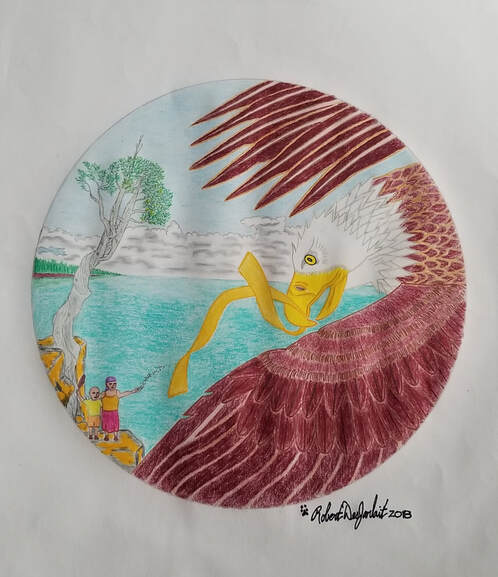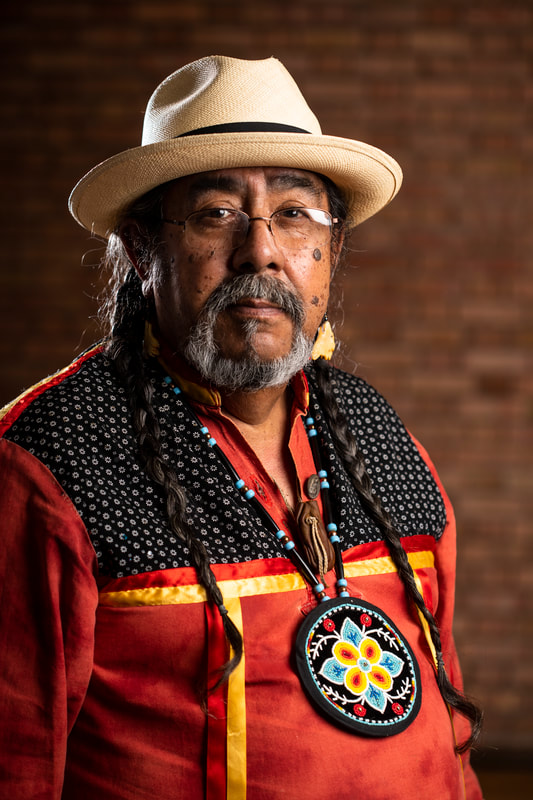|
“One day, the Earth was submerged by a destructive flood sent by Mishibijiw, the Great Underwater Serpent. Nenabozho, our Great Uncle, survived. Drifting on a log, he obtained pebbles of dirt from the muskrat. After planting the dirt on his log, the Earth regrew and new life reemerged from the life that existed before.” In April 2013, I heard the three words that you don’t want to hear – you have cancer. I thought my life was over. I was 66 years old, retired, and at that point in my life, art was far from my mind. One day, I took a walk in the halls of the cancer ward with my IV stand rolling beside me. My prognosis was good. Following surgery for the removal of my ascending colon, my cancer was classified as Stage I meaning the cancer hadn’t metastasized and chemo wasn’t required. As I walked along the hallways of the cancer ward, I saw walls covered in art. I had no idea who the artists were. I asked a nurse: “Who are the artists?” She replied that some of them were by former cancer patients and others were from families who had lost a loved one to the disease. And, therein, a seed was sown and a promise made that someday I would return with a painting to join the walls of art in the cancer ward. But any aspirations of returning to art came to a jolting halt in May 2016. My annual CT scan revealed a lesion on the left lobe of my liver. This time around, my surgery was preceded by four rounds of neoadjuvant chemo and followed by twelve rounds of adjuvant chemo. As a result of my recurrence, I became a Stage IV cancer survivor. In November 2018, Reemergence became a part of my cancer journey. Cancer survivors live a cautiously optimistic life. We really can’t look too far into the future. Goals and priorities need to be in the short term. The ideas that floated through my mind in the cancer ward came to fruition. But it was really a question of whether I could return, or more specifically reemerge, to the fine art form I established in the 1980s. “Gidagaabinesh” (Spotted Bird) was the first work and a tribute to Herb Sam, one of my spiritual mentors and advisors who passed from liver cancer in September 2018. I didn’t have watercolors or brushes, so I decided to use colored pencils and, for the first time, watercolor pencils. I decided to do the work encompassed in a circle – the circle was a hallmark of my illustration art in the 1990s and early 2000s. “Gidagaabinesh” was a test of sorts. Did I retain my skills as a fine artist after a nearly 35 year absence? Or had my abilities diminished? With the finished work, I found that my palette hadn’t lessened and my aesthetics had matured. Indeed, rather than being diminished, they had improved. It was almost as if they had been in limbo and waited for the reopening of the channels to my creativity. I did a sister piece - “Aazha miinawaa Manidoo-Giizhikens” (Aazha and the Spirit Tree) with two main characters from a children’s book I’m writing about two Ojibwe children with childhood cancers. Manidoo-Giizhikens (the Spirit Tree) has a special place in my heart following a photo shoot there in 2016 with well-known photographer Ivy Vainio. After completing the two works, I decided to create a body of work called Reemergence. From late November to late January, I worked on a number of pencil studies that would form the series. The art largely reflected the themes I developed in the 1980s – scenes of the traditional, everyday roles of Ojibwe-Anishinaabe women and men in the 1700s-1800s. In mid-March, I obtained watercolors, gouache (a new medium for me), and brushes, and began working on the paintings. By mid-June, I completed 15 paintings for a total of 17 works for the Reemergence series. The title reflects my reemergence as a fine artist. But it also reflects my reemergence after battling cancer for seven years. Reemergence is not cancer art per se; rather, it’s art by a cancer survivor who is Ojibwe-Anishinaabe who is an artist. The art is a paradigm of creativity and healing in a time of sickness. However, Reemergence has a deeper meaning. In a cultural context, Nenabozho’s story has a metaphorical meaning in relation to my cancer experience. Cancer and Mishibijiw are interrelated as malevolent beings that bring death, chaos, and destruction. The log is my physical body and Nenabozho represents my spirit. The pebbles of dirt are the medicines that help heal me. And, forthwith, a new life reemerges from the life that existed before. Our elders teach that our personal lives move in a circle. We always come back to a point that we’ve left behind. We may bypass the point and move on. Or we may stop at the point and find something that provides a deeper meaning and direction on our path. With Reemergence, I’ve reached such a point.
0 Comments
|
AuthorRobert DesJarlait Archives
September 2023
Categories |



 RSS Feed
RSS Feed